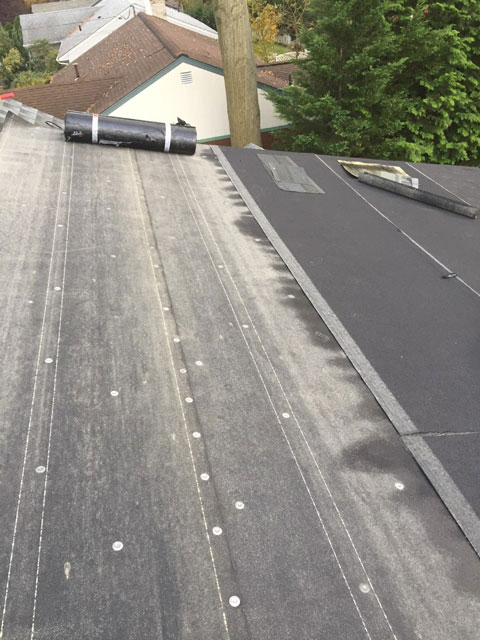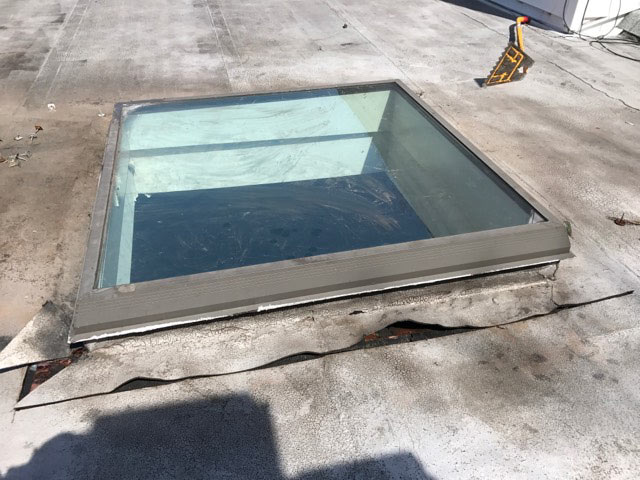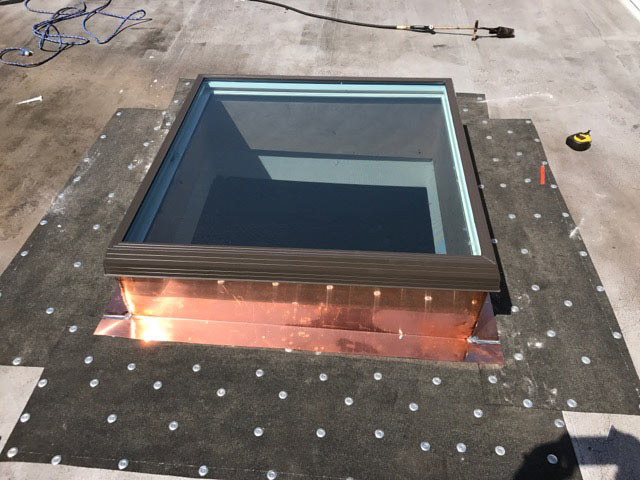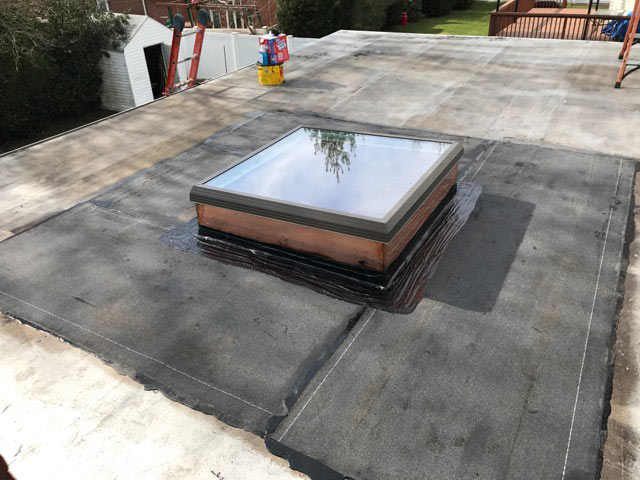Flat Roof Repairs Suffolk County
Flat Roof Leaks Suffolk County
Flat roof materials last usually 15-20 years with some commercial grade applications lasting up to 30 years. Some flat roofs, however leak within 5-10 years of installation, due to openings in roof at penetrations. (vent pipes, a/c units, fence posts and perimeter flashing).
Flat Roof Repairs Suffolk County
Residential
Wall flashing: The most common residential flat roof leak occurs where flat roofing meets siding. The ‘flashing’ at this joint is crucial. Flashing comes in many forms. Flashing can be copper, aluminum, lead or tar. That’s right, tar. The best form of flashing with residential flat (low slope) roofing is actually none of these. Whether it is a metal or the roof sealed right to the siding, either way, it can fail. If the flat roofing were to continue up the wall behind the siding, there is no tar to fail. This method will last as long as the material. It will not fail. Physics never fails. Tricky part to this is the layers of siding. To be done properly, the flat roof (we prefer Rubber roofing) needs to continue behind all layers of siding (vinyl, insulation, asbestos and tar paper is most common).
Plumbing pipes and chimney stacks: Leaks from penetrations are easily fixed using trowel applied flashing, but Silicone based sealant with polyester fabric lasts 3-4 times as long as traditional tar-flashing.
Perimeter trim: Many roofers do not create enough overhang or the sealant they use to seal membrane to aluminum fails because it was not intended to be reliant on (1) seal that WILL FAIL. Aluminum drip edge and gutters require redundant layering of material behind and into gutter. Material on edges must be wrapped and fastened over the side, covered by aluminum edge flashing/drip edge and then fasteners patched along top edge of metal.
Failed roof seams: Failed seams can result from weather conditions during application, failed material or Poor Workmanship. TPO and Modified Bitumen roofs are our GO-TO roofing membranes for residential and commercial applications as they both utilize MOLECULAR WELDING. When trained properly (and with the help of precision Robot welders) instant bonding thru heat welding is achieved. Most residential roofers lack proper insurance and/or skill-set to install these products. High temperatures are used to WELD the material in temperatures as low as 35 degrees. Peal and Stick roofing was created for the poorly insured or non-insured roofer (sold at HOME DEPOT) but requires multiple layers to deal with the likelihood that a seam will fail and temperatures need to be 60 degree or more (to avoid using a torch). EPDM is a great material that can last 30 or more years but the seams require extensive prep work, minimum temperature requirement, air moisture affects the bond, the bonding materials have expiration and storage requirements and the set up time is variable based on many conditions, all together creating too much RISK. EPDM is however very flexible and comes in the largest sheets (as wide as 20 feet). It is black vs. TPO is white and therefore needed for aesthetics. For flexibility, small jobs and tight spaces where heat should not be used EPDM is used.
Click an image below to view gallery:
Commercial and Industrial Roof Suffolk NY
Commercial and industrial flat roofs have perimeter issues related to gutters, coping, wall joints, issues at all penetrations and the trickiest leak – HVAC units.
Roof perimeters: Often kept inches’ shy of the edge and neatly sealed to existing or new metal using tar (and fiberglass fabric in most cases). This seal will eventually fail allowing water directly in to building or worse, in between layers of flat roofing, sometimes not noticed until roof becomes beyond repair. The adhesion between top roof and underlying roofs is vital to the top roofs survival (longevity), so avoiding leaks on a multi layered roof is vital. It is as simple as adding about 4 inches of material to the roof perimeter. This enables the roof to continue over the edge, overlapping wall or existing metal coping. This raw edge is then finished with an aluminum drip edge to fasten and cover roofing.
Failed roof seams: Failed seams can result from weather conditions during application, failed material or Poor Workmanship. In some cases, roof seams fail because the underlying roof, decking or insulation is moving. Improper fastening of deck, insulation, base sheet or dis-adhesion of underlying roof from deck can transfer stress resulting from contraction of building, causing seems to be pulled apart. Understanding the cause (not the effect) is essential in this case. Leaks from the perimeter, internal moisture (condensation) resulting from poor insulation or leaks in the building envelope need to be explored before seams are patched. More often than not the roof seams on a multiple layered Suffolk County low slope roof are failing because of other catalysts. TPO and Modified Bitumen roofs are our GO-TO roofing membranes for commercial applications as they both utilize MOLECULAR WELDING. When trained properly (and with the help of precision Robot welders) instant bonding thru heat welding is achieved. EPDM is a great material that can last 30 or more years but the seams require extensive prep work, minimum temperature requirement, air moisture affects the bond, the bonding materials have expiration and storage requirements and the set up time is variable based on many conditions, all together creating too much RISK. EPDM is however very flexible and comes in the largest sheets (as wide as 20 feet). It is black vs. TPO is white and therefore needed for aesthetics. For flexibility, small jobs and tight spaces where heat should not be used EPDM is used.
Other Common Roof Leak Situations in Suffolk County NY
Click the links below to read about other common leaks that can affect your home.
Warning: Undefined variable $post in /home/lms2012/public_html/leakstoppersinc.com/wp-content/themes/leakstoppers/functions.php on line 82
- Atrium Services
- Careers
- Commercial Roofing & Repairs Nassau County
- Commercial Roofing & Repairs Suffolk County
- Contact Us
- Expert Roof Leak Repair on Long Island
- Flat Roof Repairs Nassau County
- Frequently Asked Questions
- GAF Warranty Services
- Guarantee
- Home Show Inquiry
- How did we do?
- Leak Stoppers Warranties
- Leak Stoppers, Roof Leak Repair Experts!
- Long Island Commercial Roofing & Repairs
- Long Island Residential Roofing
- Manufacturer Titles
- Nassau County Attic Leak Repairs
- Nassau County Chimney Leak Repairs
- Nassau County Residential Roofing
- Nassau County Skylight Leak Repairs
- Our Services
- Long Island Attic Leak Repairs
- Long Island Chimney Leak Repairs
- Long Island Flat Roof Repairs
- Long Island Ice Dam Removal & Damage Repair
- Long Island Negative Air Repairs
- Long Island Siding Leak Repairs
- Long Island Skylight Leak Repairs
- Long Island Valley Leak Repairs
- Long Island Vent Pipe Leak Repairs
- Long Island Window Leak Repairs
- Residential Skylight Services
- Roof Leak Repair Experts in Albertson NY
- Roof Leak Repair Experts in Amagansett NY
- Roof Leak Repair Experts in Amityville NY
- Roof Leak Repair Experts in Aquebbogue NY
- Roof Leak Repair Experts in Asharoken NY
- Roof Leak Repair Experts in Atlantic Beach NY
- Roof Leak Repair Experts in Babylon NY
- Roof Leak Repair Experts in Baiting Hollow NY
- Roof Leak Repair Experts in Baldwin Harbor NY
- Roof Leak Repair Experts in Baldwin NY
- Roof Leak Repair Experts in Baxter Estate NY
- Roof Leak Repair Experts in Bay Shore NY
- Roof Leak Repair Experts in Bayport NY
- Roof Leak Repair Experts in Bayville NY
- Roof Leak Repair Experts in Belle Terre NY
- Roof Leak Repair Experts in Bellerose NY
- Roof Leak Repair Experts in Bellmore NY
- Roof Leak Repair Experts in Bellport NY
- Roof Leak Repair Experts in Bethpage NY
- Roof Leak Repair Experts in Blue Point NY
- Roof Leak Repair Experts in Brentwood NY
- Roof Leak Repair Experts in Bridgehampton NY
- Roof Leak Repair Experts in Brightwaters NY
- Roof Leak Repair Experts in Brookhaven NY
- Roof Leak Repair Experts in Brookville NY
- Roof Leak Repair Experts in Carle Place NY
- Roof Leak Repair Experts in Cedarhurst NY
- Roof Leak Repair Experts in Center Moriches NY
- Roof Leak Repair Experts in Centereach NY
- Roof Leak Repair Experts in Centerport NY
- Roof Leak Repair Experts in Central Islip NY
- Roof Leak Repair Experts in Centre Island NY
- Roof Leak Repair Experts in Cold Spring Harbor NY
- Roof Leak Repair Experts in Commack NY
- Roof Leak Repair Experts in Coram NY
- Roof Leak Repair Experts in Cove Neck NY
- Roof Leak Repair Experts in Cutchogue NY
- Roof Leak Repair Experts in Deer Park NY
- Roof Leak Repair Experts in Dix Hills NY
- Roof Leak Repair Experts in East Hampton NY
- Roof Leak Repair Experts in East Hills NY
- Roof Leak Repair Experts in East Marion NY
- Roof Leak Repair Experts in East Meadow NY
- Roof Leak Repair Experts in East Moriches NY
- Roof Leak Repair Experts in East Northport NY
- Roof Leak Repair Experts in East Norwich NY
- Roof Leak Repair Experts in East Quogue NY
- Roof Leak Repair Experts in East Setauket NY
- Roof Leak Repair Experts in East Williston NY
- Roof Leak Repair Experts in Eastport NY
- Roof Leak Repair Experts in Eatons Neck NY
- Roof Leak Repair Experts in Elmont NY
- Roof Leak Repair Experts in Elwood NY
- Roof Leak Repair Experts in Farmingdale NY
- Roof Leak Repair Experts in Farmingville NY
- Roof Leak Repair Experts in Floral Park NY
- Roof Leak Repair Experts in Flower Hill NY
- Roof Leak Repair Experts in Fort Salonga NY
- Roof Leak Repair Experts in Franklin Square NY
- Roof Leak Repair Experts in Freeport NY
- Roof Leak Repair Experts in Garden City NY
- Roof Leak Repair Experts in Garden City Park NY
- Roof Leak Repair Experts in Glen Cove NY
- Roof Leak Repair Experts in Glen Head NY
- Roof Leak Repair Experts in Glenwood Landing NY
- Roof Leak Repair Experts in Gordon Heights NY
- Roof Leak Repair Experts in Great Neck Estate NY
- Roof Leak Repair Experts in Great Neck Gardens NY
- Roof Leak Repair Experts in Great Neck NY
- Roof Leak Repair Experts in Greenlawn NY
- Roof Leak Repair Experts in Greenport NY
- Roof Leak Repair Experts in Greenvale NY
- Roof Leak Repair Experts in Hampton Bays NY
- Roof Leak Repair Experts in Hauppauge NY
- Roof Leak Repair Experts in Hempstead NY
- Roof Leak Repair Experts in Herricks NY
- Roof Leak Repair Experts in Hewlett NY
- Roof Leak Repair Experts in Hicksville NY
- Roof Leak Repair Experts in Holbrook NY
- Roof Leak Repair Experts in Holtsville NY
- Roof Leak Repair Experts in Huntington NY
- Roof Leak Repair Experts in Inwood NY
- Roof Leak Repair Experts in Island Park NY
- Roof Leak Repair Experts in Islandia NY
- Roof Leak Repair Experts in Islip NY
- Roof Leak Repair Experts in Jamesport NY
- Roof Leak Repair Experts in Jericho NY
- Roof Leak Repair Experts in Kensington NY
- Roof Leak Repair Experts in Kings Park NY
- Roof Leak Repair Experts in Kings Point NY
- Roof Leak Repair Experts in Lake Grove NY
- Roof Leak Repair Experts in Lake Ronkonkoma NY
- Roof Leak Repair Experts in Lake Success NY
- Roof Leak Repair Experts in Lakeview NY
- Roof Leak Repair Experts in Lakeville Estates NY
- Roof Leak Repair Experts in Lattingtown NY
- Roof Leak Repair Experts in Laurel Hollow NY
- Roof Leak Repair Experts in Laurel NY
- Roof Leak Repair Experts in Lawrence NY
- Roof Leak Repair Experts in Levittown NY
- Roof Leak Repair Experts in Lido Beach NY
- Roof Leak Repair Experts in Lindenhurst NY
- Roof Leak Repair Experts in Lindenhurst NY
- Roof Leak Repair Experts in Lloyd Harbor NY
- Roof Leak Repair Experts in Locust Valley NY
- Roof Leak Repair Experts in Long Beach NY
- Roof Leak Repair Experts in Lynbrook NY
- Roof Leak Repair Experts in Malverne NY
- Roof Leak Repair Experts in Manhasset Hills NY
- Roof Leak Repair Experts in Manhasset NY
- Roof Leak Repair Experts in Manorhaven NY
- Roof Leak Repair Experts in Manorville NY
- Roof Leak Repair Experts in Massapequa NY
- Roof Leak Repair Experts in Massapequa Park NY
- Roof Leak Repair Experts in Mastic Beach NY
- Roof Leak Repair Experts in Mastic NY
- Roof Leak Repair Experts in Matinecock NY
- Roof Leak Repair Experts in Mattituck NY
- Roof Leak Repair Experts in Medford NY
- Roof Leak Repair Experts in Melville NY
- Roof Leak Repair Experts in Merrick NY
- Roof Leak Repair Experts in Middle Island NY
- Roof Leak Repair Experts in Mill Neck NY
- Roof Leak Repair Experts in Miller Place NY
- Roof Leak Repair Experts in Mineola NY
- Roof Leak Repair Experts in Montauk NY
- Roof Leak Repair Experts in Moriches NY
- Roof Leak Repair Experts in Mt. Sinai NY
- Roof Leak Repair Experts in Muttontown NY
- Roof Leak Repair Experts in Nassau County
- Roof Leak Repair Experts in Nesconset NY
- Roof Leak Repair Experts in New Hyde Park NY
- Roof Leak Repair Experts in North Hills NY
- Roof Leak Repair Experts in Northport NY
- Roof Leak Repair Experts in Oceanside NY
- Roof Leak Repair Experts in Old Bethpage NY
- Roof Leak Repair Experts in Old Brookville NY
- Roof Leak Repair Experts in Old Field NY
- Roof Leak Repair Experts in Old Westbury NY
- Roof Leak Repair Experts in Orient NY
- Roof Leak Repair Experts in Oyster Bay NY
- Roof Leak Repair Experts in Patchogue NY
- Roof Leak Repair Experts in Peconic NY
- Roof Leak Repair Experts in Plainedge NY
- Roof Leak Repair Experts in Plainview NY
- Roof Leak Repair Experts in Plandome NY
- Roof Leak Repair Experts in Point Lookout NY
- Roof Leak Repair Experts in Poquott NY
- Roof Leak Repair Experts in Port Jefferson NY
- Roof Leak Repair Experts in Port Washington NY
- Roof Leak Repair Experts in Quogue NY
- Roof Leak Repair Experts in Remsenburg NY
- Roof Leak Repair Experts in Ridge NY
- Roof Leak Repair Experts in Riverhead NY
- Roof Leak Repair Experts in Rockville Centre NY
- Roof Leak Repair Experts in Rocky Point NY
- Roof Leak Repair Experts in Roosevelt NY
- Roof Leak Repair Experts in Roslyn Heights NY
- Roof Leak Repair Experts in Roslyn NY
- Roof Leak Repair Experts in Saddle Rock NY
- Roof Leak Repair Experts in Sag Harbor NY
- Roof Leak Repair Experts in Sagaponack NY
- Roof Leak Repair Experts in Sands Point NY
- Roof Leak Repair Experts in Sea Cliff NY
- Roof Leak Repair Experts in Seaford NY
- Roof Leak Repair Experts in Searingtown NY
- Roof Leak Repair Experts in Selden NY
- Roof Leak Repair Experts in Setauket NY
- Roof Leak Repair Experts in Shelter Island NY
- Roof Leak Repair Experts in Shinnecock Hills NY
- Roof Leak Repair Experts in Shinnecock NY
- Roof Leak Repair Experts in Shirley NY
- Roof Leak Repair Experts in Shoreham NY
- Roof Leak Repair Experts in Sound Beach NY
- Roof Leak Repair Experts in Southampton NY
- Roof Leak Repair Experts in Southold NY
- Roof Leak Repair Experts in Speonk NY
- Roof Leak Repair Experts in Springs NY
- Roof Leak Repair Experts in St. James NY
- Roof Leak Repair Experts in Stewart Manor NY
- Roof Leak Repair Experts in Stony Brook NY
- Roof Leak Repair Experts in Suffolk County
- Roof Leak Repair Experts in Syosset NY
- Roof Leak Repair Experts in Terryville NY
- Roof Leak Repair Experts in Uniondale NY
- Roof Leak Repair Experts in Upton NY
- Roof Leak Repair Experts in Valley Stream NY
- Roof Leak Repair Experts in Wading River NY
- Roof Leak Repair Experts in Wainscott NY
- Roof Leak Repair Experts in Wantagh NY
- Roof Leak Repair Experts in Water Mill NY
- Roof Leak Repair Experts in West Hills NY
- Roof Leak Repair Experts in West Islip NY
- Roof Leak Repair Experts in West Sayville NY
- Roof Leak Repair Experts in Westbury NY
- Roof Leak Repair Experts in Westhampton Beach NY
- Roof Leak Repair Experts in Westhampton NY
- Roof Leak Repair Experts in Williston Park NY
- Roof Leak Repair Experts in Woodbury NY
- Roof Leak Repair Experts in Woodbury NY
- Roof Leak Repair Experts in Woodmere NY
- Roof Leak Repair Experts in Wyandanch NY
- Roof Leak Repair Experts in Yaphank NY
- Suffolk County Attic Leak Repairs
- Suffolk County Chimney Leak Repairs
- Suffolk County Residential Roofing
- Suffolk County Skylight Leak Repairs
- Testimonials
- Thank You for Contacting Leak Stoppers
- The Leak Stopper Difference
- The Leak Stoppers Blog
- Thermal Imaging, Moisture Meters & Drone Technology






